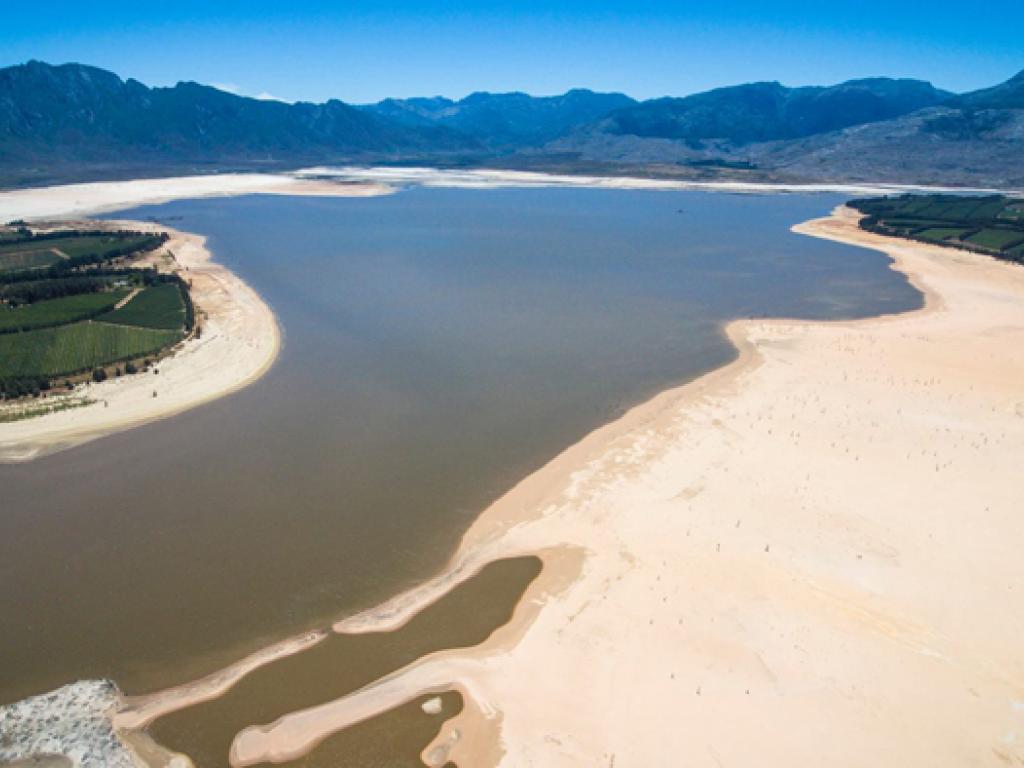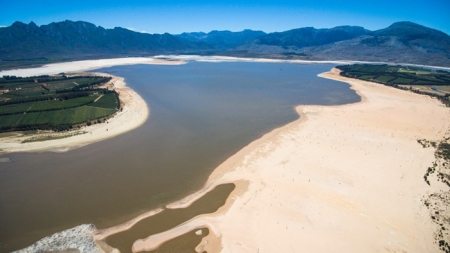Waiting for the rain


Extremely low levels of water currently in the Theewaterskloof Dam, the largest dam serving the City of Cape Town.
Cape Town residents are increasingly familiar with the constraints of water use – the region is in the grip of its third major drought since 2001.
In April 2005, for example, the water storage capacity of the main supply dams reached an all-time low of just 26% overall. In this case, the City of Cape Town (CoCT) had already imposed Level 2 water restrictions (1 January 2005) in an effort to reduce consumption by 20%. Records show that consumers did adhere to the restrictions and the City was able to meet the intended reduction. There was some relief on 20 April when an intense, localised thunderstorm brought about 130 mm of rain to the catchment that feeds the Theewaterskloof Dam. By late June 2005 the overall dam storage capacity was a little over 50%, which is usual for mid-year early winter conditions.
The current conditions in 2017 appear to be similar to that of 2005, but in the present moment there is heightened uncertainty. The overall storage capacity of the dams decreases by between 1.5 and 1.8% each week under the current weather conditions and demand. Given the current water storage capacity of approximately 40% (23 January 2017), and with limits on the drawdown for most dams being between 10 and 15%, and if there is no significant rainfall ahead, the risk level could be serious. There is no doubt that it will rain, but waiting is uncomfortable and unsettling for all. Short term rainfall forecasts are unable to provide answers to three of the most important questions right now: When will it rain? How much will it rain? Where will the rain fall?
The CoCT receives about 98.5 % of its potable water supply from surface water resources. The Western Cape Water Supply System (WCWSS) comprises a network of major and minor dams, which are all used to store winter runoff. Six major dams, located in the mountain catchments areas in the Boland and Hottentots-Holland mountain ranges, supply 99.6% of CoCT’s raw water. The WCWSS has an annual yield of 556 million cubic metres of which 399 million cubic metres is allocated to the CoCT, while the remaining yield is allocated to other urban areas and for agriculture. There are plans to augment surface water resource by 2020, but this might be too long to wait.
The imposition of water restrictions by the City is uncomfortable and it creates uncertainty among consumers, but it is clearly necessary. The City has stepped up the restrictions from Level 2 to Level 3 restrictions (1 December 2016) and are likely to implement Level 3B restrictions soon. At the same time, the City has struggled to inform consumers about the requirements of each level, and each level requires a response that is increasingly nuanced. To the credit of the City, policies and weekly updates on the water supply have been well managed on the City’s website.
Water resource options
The official response is that taps will not run dry before the winter rainfall period although there are many views that are being expressed to the contrary on social media and other media platforms. Hopefully it will rain in time, but it is an anxious wait.
Given the three droughts that have occurred over the past 15 years, in relatively quick succession, there should be more than enough motivation to actively commit to incorporating a variety of water supply and treatment options into the overall water resources mix.
Over the last 10 years and more, a variety of water resource options have been explored, for example, augmenting supplies from the Table Mountain Group aquifer, including the Cape Flats aquifer; the Reclaim Camissa project, which utilises spring water from Table Mountain; domestic rainwater harvesting and grey-water systems; the use of storm water as a resource; and improving the quality, supply and distribution of treated effluent for business enterprises, golf courses and large institutions.
These options are all reasonably well researched both in Cape Town and elsewhere. It is time to test and implement many of these systems. These options have the potential to enable Cape Town to become a water-resilient and water-sensitive city that is capable of dealing with the uncertainty of water supply in an increasingly water scarce region.
In future we should not be caught waiting for the rain.
Download, print and display the CoCT water-saving tips poster...
Story Kevin Winter. Photo Johnny Miller / Code For Africa.